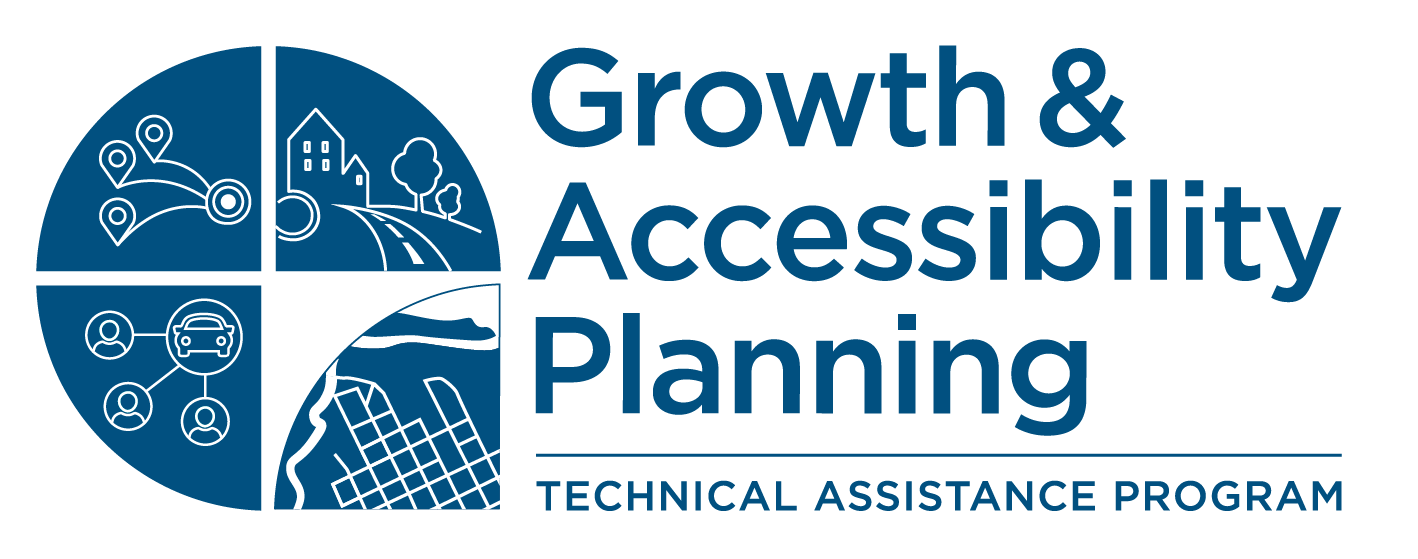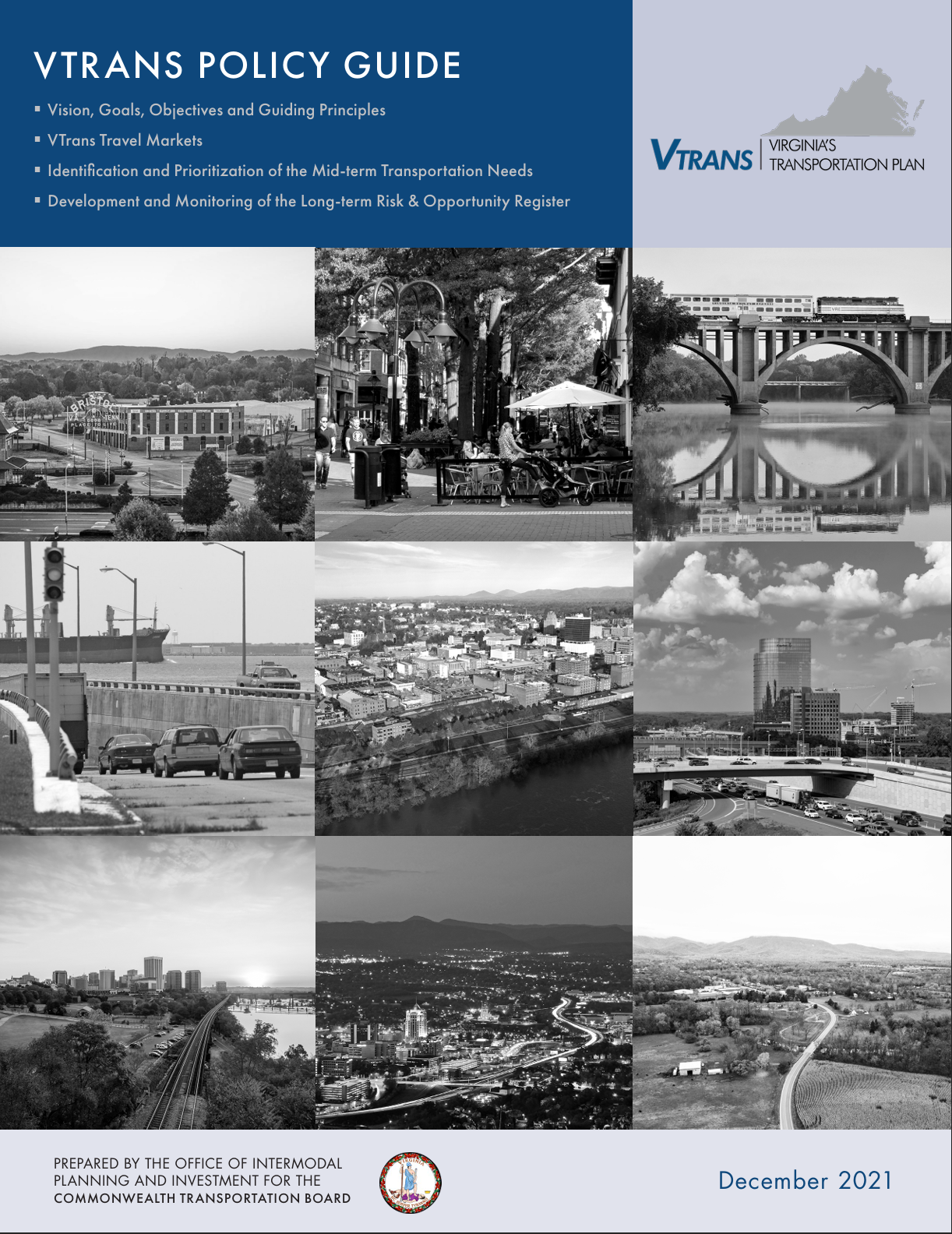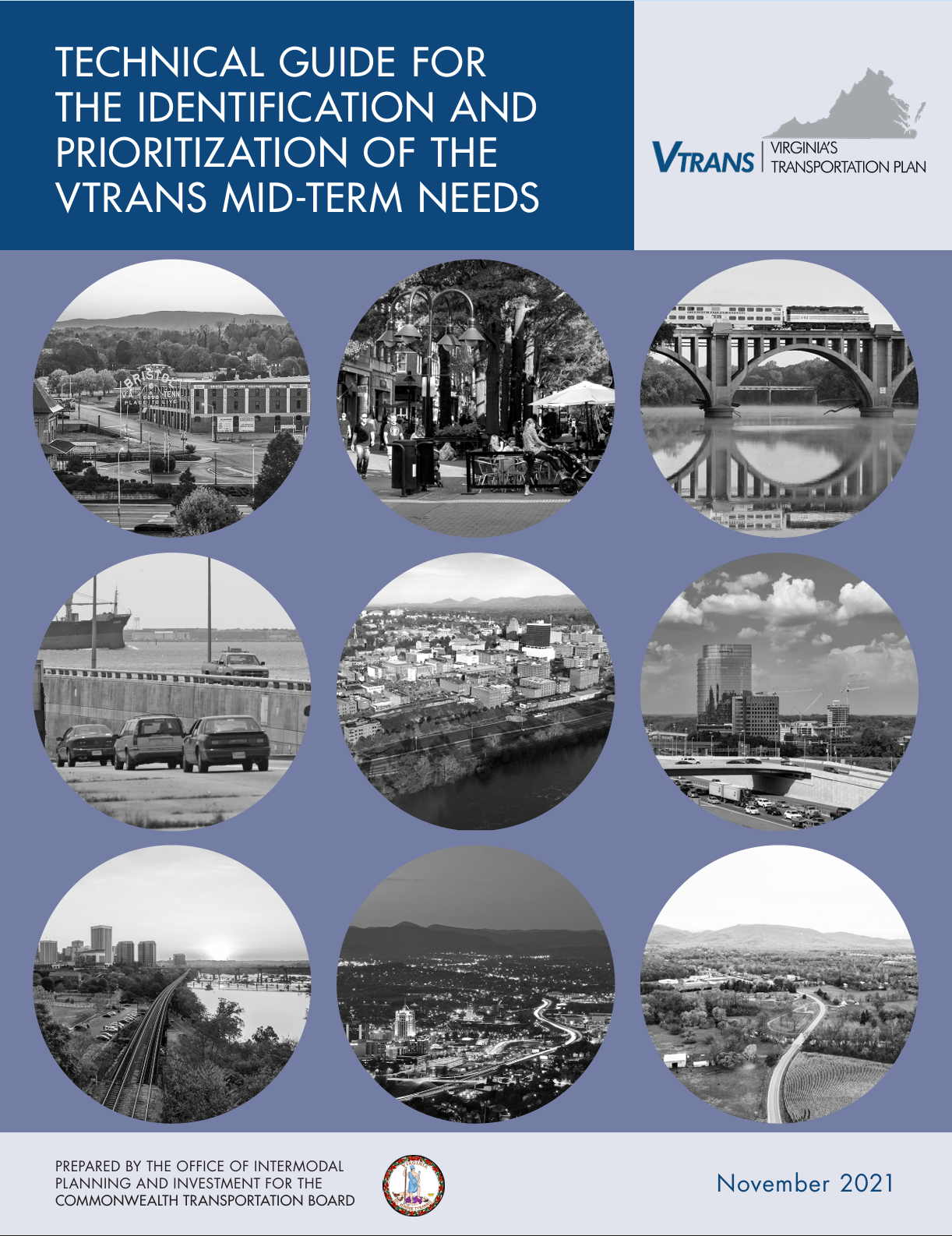Identifying Virginia's Needs for the Next 10-15 Years
Connecting current trends to future action—one need at a time.
Mid-term Needs and Priorities
Transportation needs for the next 10 years are called “mid-term needs.” VTrans identifies and prioritizes these needs and then addresses them with projects, policies, and programs.
Projects that help address these needs may become eligible for state funding under the SMART SCALE program. They may also receive priority consideration in VDOT’s Revenue Sharing program.
Locations VTrans rank as "Priority 1" (top priority) become eligible for study funding under the Project Pipeline program.
On This Page
Mid-term Needs Policy and Guide
The Commonwealth Transportation Board (CTB) has established policies to identify and prioritize capacity and safety-related transportation needs. These policies use performance-based planning to provide transparency and clarity to local and regional partners. Changing these policies requires CTB action.
For more information, use these resources:
- The VTrans Policy Guide (v6) provides a framework and details for all VTrans related policies. Chapter 4 of the policy guide focuses on the identification of VTrans Mid-term Needs and Chapter 5 includes the prioritization of the VTrans Mid-term Needs.
- The 2021 Technical Guide for the Identification and Prioritization of the Mid-term Needs documents data sources, methods, and processes for planners and engineers. The outdated 2019 version of the Technical Guide can be found here.
The Technical Guide may continue to evolve and improve with advances in technology, data collection, and reporting tools. If such improvements modify or affect the policy and process, they are brought to the CTB for review and approval.
How are Mid-term Needs Identified and Prioritized?
Identification
VTrans identifies mid-term needs to advance the goals and objectives established by the CTB over the next 10 years. For each goal, one or more performance measures are identified. These are numeric descriptions of a transportation system’s performance or condition. Stakeholders are consulted before any changes are made to policy to identify and prioritize needs.
Prioritization
After the needs are identified, they are prioritized so locations with more pressing needs can be focused on. Locations with overlapping needs can be prioritized together for efficiency.
Needs are prioritized with this four-step process
Step 1: Define Geographical Levels of Prioritization
The first step is creating guidelines for grouping needs by category.
This is done by location:
Statewide Prioritization: Needs¹ within the Corridors of Statewide Significance (CoSS) and Safety Travel Markets²
Construction District Prioritization: Needs¹ within the Corridors of Statewide Significance (CoSS), Regional Networks (RN), Safety, and UDA (IEDA Access) Travel Markets²
Notes
- Needs categories vary by Travel Market and include a wide range of multimodal needs such as congestion, transit access, pedestrian access, etc.
- There are four (4) Travel Markets, each with a unique set of characteristics. Please refer to the VTrans Travel Markets page for a more detailed description.
Step 2: Prioritize within Needs Categories
Establish priorities within each category.
This step uses two criteria:
Criteria 1: Severity of the Need
Criteria 2: Magnitude (Number of Users, Vehicles, etc. Affected)
Step 3: Weigh and Aggregate across Needs Categories
Step 4: Adjust Priority Locations for Influencing Factors
Adjust for influencing factors.
These influencing factors help set priority:
- Co-located transportation infrastructure repair, rehabilitation, or replacement needs
- Exposure to the projected sea-level rise, storm surge, and historical riverine/inland flooding
- Co-located Economically Distressed Communities
For more detailed info, check out the VTrans Policy Guide and the 2021 Technical Guide for the Identification and Prioritization of the Mid-term Needs.
Established VTrans Mid-term Needs and Priorities
VTrans mid-term needs and priority locations can be viewed using the map widget below. Please use InteractVTrans MapExplorer to print, download, or comment. Explore more statistics with the interactive visualization app InteractVTrans DataExplorer.
More About Needs
- A proposed solution to address a VTrans mid-term need does not have to be located in the same place as the need. A solution must only address the purpose in need and effectiveness.
- A VTrans need category does not specify a type or mode of response. For example, a solution to the need for Improved Reliability may not focus on roadways. It could instead be addressed by multimodal infrastructure improvements such as transit or rail services or park-and-ride infrastructure.
- Similarly, a need for improved reliability may also be addressed by policies (e.g., variable pricing, occupancy or vehicle restrictions, etc.) or programs such as commuter assistance programs.
Frequently Asked Questions
Have more VTrans questions? Find answers on our FAQ page.
What are the VTrans Mid-term Needs?
The Commonwealth Transportation Board (CTB) created a policy in January 2020 to identify capacity and safety-related transportation needs. In March 2021, the CTB adopted a policy to prioritize these needs. Both policies use performance-based planning to make the process clear and transparent for local and regional partners.
The VTrans Mid-term Needs framework looks at transportation needs in three travel markets and also includes a statewide safety assessment:
- Corridors of Statewide Significance (CoSS) – Interregional travel
- Regional Networks (RNs) – Intraregional travel
- Urban Development Areas (UDAs) and Industrial and Economic Development Sites (IEDAs) – Local travel
For full details, see the Mid-term Needs and Priorities page.
Where can I find the full list of VTrans Mid-term Needs for my jurisdiction?
Go to InteractVTrans MapExplorer. You can view the 2021 and 2019 VTrans Mid-term Needs there. You can also see the 2019 Statewide Prioritized Mid-term Needs and the Construction District Prioritized Mid-term Needs. The tool lets you search and download the data.
What is the planning horizon for the VTrans Mid-term Needs?
VTrans Mid-term Needs focuses on locations that may need attention in the next ten years.
What was the basis for identifying performance measures for the VTrans Mid-term Needs?
The measures come from the CTB-adopted policy for identifying and prioritizing VTrans Mid-term Needs. The policy was created with input from localities, MPOs (Metropolitan Planning Organizations), PDCs (Planning District Commissions), and CTB (Commonwealth Transportation Board) members.
What does each performance measure tell us?
VTrans uses several performance measures to find Mid-term Needs. These measures cover congestion, reliability, accessibility, safety, capacity preservation, transportation demand management, and industrial and economic development access.
- Congestion: Identifies locations where travel is much slower than the speed limit or takes longer than normal.
- Reliability: Finds locations with unpredictable travel times or where extra time is needed to arrive on time. Includes average on-time arrival for Amtrak and Virginia Rail Express trains.
- Accessibility: Identifies areas needing better access by transit, bike, or walking. This includes regional Activity Centers where transit is not competitive with driving and Equity Emphasis Areas where transit is needed.
- Safety: Identifies roads and intersections with high crash rates, fatalities, or injuries. Includes corridors with pedestrian safety needs.
- Urban Development Areas (UDAs): Lists locally identified needs for improving circulation in designated UDAs to support traditional neighborhood design.
- Capacity Preservation: Identifies roads where small investments now can avoid costly fixes later.
- Transportation Demand Management (TDM): Shows places where proactive travel demand management is needed based on roadway and area type.
- Industrial and Economic Development Areas (IEDAs): Identifies sites that need better access to the nearest Corridor of Statewide Significance (CoSS).
More information is on the VTrans Mid-term Needs and Priorities page.
How are performance measures used to identify VTrans Mid-term Needs?
A performance measure is a number that describes a condition. It is based on data. It can describe the condition of a roadway segment or a transit service.
The CTB sets thresholds for conditions that need attention within the next ten years. If a roadway or transit service meets one of these thresholds, it is flagged as a Mid-term Need.
How are needs in rural and slow-growth areas reflected in the Mid-term Needs?
Rural needs outside of Regional Networks (RNs) are identified through the Corridors of Statewide Significance (CoSS) and Urban Development Area (UDA) travel markets.
Safety Needs can occur on any state road. They are not limited by travel market.
How does VTrans consider changes in technology and other external factors?
VTrans reviews changes in technology and other outside factors through the Long-term Risk and Opportunity Register. This process tracks major trends and risks. It also looks at opportunities that could affect transportation in Virginia.
These trends include things like new technology, climate change, population shifts, and changes in travel behavior. VTrans uses this information to guide planning and investment decisions.
Why prioritize transportation needs?
There are too many transportation needs in Virginia to address all at once. Prioritizing helps identify the locations with the most urgent needs.
Locations identified as priorities under the CTB policy become eligible for funding. They can also be evaluated further through the Virginia Project Pipeline program.
Local and regional planning agencies can use the prioritized needs to guide their own planning work.
What is the VTrans Multimodal Project Development Pipeline?
The Virginia Project Pipeline Program uses the prioritized VTrans Mid-term Needs to guide investments. This helps ensure transparency, accountability, and efficient project delivery. It also supports performance-based planning and programming, following the CTB’s VTrans Guiding Principles.
The process includes:
- Prioritize VTrans Mid-term Needs.
- Identify locations for studies or solutions.
- Conduct studies and develop solutions.
- Use results to inform VDOT and DRPT funding programs, including SMART SCALE.
Will the full Mid-term Needs list still be relevant once the Needs are prioritized?
Yes. The Policy for the Prioritization of the VTrans Mid-term Needs does not remove identified needs. It only ranks them to show which are the most urgent.
Where can I find more details on the VTrans needs prioritization policy?
You can read Chapter 5 of the VTrans Policy Guide on this webpage. It explains the policy and shows which Needs categories are in each Priority Location.
How statewide and district priorities are set:
- Statewide Prioritization: Needs in the Corridors of Statewide Significance (CoSS) and Safety Travel Markets.
- Construction District Prioritization: Needs in the CoSS, Regional Networks (RN), Safety, and UDA (IEDA Access) travel markets.
Notes:
- Needs categories vary by travel market. They include many types of multimodal needs like congestion, transit access, and pedestrian access.
- There are four travel markets, each with unique characteristics. See the VTrans Travel Markets page for details.
Steps to set VTrans priorities:
- Establish priorities within each VTrans Need category.
- Use two criteria: severity of the need and magnitude (number of users or vehicles affected).
- Assign weightings to each category and combine them to set Statewide and District Priority Locations.
- Adjust for other factors:
- Overlap with transportation infrastructure repair, rehabilitation, or replacement needs.
- Exposure to projected sea-level rise, storm surge, or historical flooding.
- Overlap with Economically Distressed Communities.
What are Statewide Priority Locations?
The VTrans Mid-term Needs are ranked in two groups: Statewide Priority and District Priority.
Statewide Priority Locations are ranked across the entire state. They are not limited by VDOT Construction District or region. They include Needs in the Corridors of Statewide Significance (CoSS) travel market for:
- Congestion mitigation
- Improved reliability (highway)
- Improved reliability (intercity and commuter rail)
- Capacity preservation
- Travel demand management
- Safety improvement on CoSS
Example: A congestion mitigation need on I-64 in Henrico County would be compared to one on I-95 in Stafford County, even though they are in different corridors.
What are Construction District Priority Locations?
The VTrans Mid-term Needs are ranked in two groups: Statewide Priority and Construction District Priority.
Construction District Priority Locations are compared only within each of the nine VDOT Construction Districts. They use the following Need categories:
- Congestion mitigation (RN)
- Improved reliability (RN)
- Transit access for Equity Emphasis Areas (RN)
- Transit access to Activity Centers (RN)
- Pedestrian access to Activity Centers (RN)
- Bicycle access to Activity Centers (RN)
- Capacity preservation (RN)
- Transportation demand management (RN)
- Access to Industrial and Economic Development Areas (IEDAs)
- Roadway safety (Statewide)
- Pedestrian safety (Statewide)
Example: A Regional Network (RN) need in the Winchester RN is compared with a need in the Harrisonburg RN because both are in the Staunton Construction District. That same Winchester RN need would not be compared to one in the Richmond RN, since Richmond is in a different district.
What is the difference between Statewide Priority Locations and Construction District Priority Locations?
Statewide Priority Locations are based on needs along the Corridors of Statewide Significance travel market.
Construction District Priority Locations are based on needs in three travel markets: Regional Networks, Safety, and Industrial and Economic Development Areas (IEDAs).
You can learn more on the VTrans Travel Markets webpage.
Why does every area in the state have one weight for Statewide Priority Locations?
Corridors of Statewide Significance (CoSS) are multimodal corridors. They connect major centers of activity and support travel between cities and states.
These corridors are critical for both passenger and freight movement across Virginia. Because of their importance, they are prioritized at the statewide level. They are not compared to local or regional conditions.
If a need along a CoSS also falls within a Regional Network, it is also counted as a Regional Network Need. In that case, it is evaluated again to determine its Construction District Priority.
How was my feedback included in the policy for prioritizing VTrans Mid-term Needs?
The draft policy was shared in more than 30 briefings with Metropolitan Planning Organizations (MPOs) and Planning District Commissions (PDCs). It was also presented at four virtual workshops with over 350 participants. Several one-on-one meetings were held with agencies and jurisdictions.
This outreach produced more than 140 written comments. Three major changes were made to the policy in response.
For details, see the January 19, 2021 CTB Meeting presentation, which lists the changes. You can also read all the comments submitted on the draft policy.



